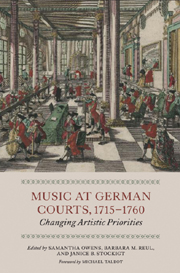Book contents
- Frontmatter
- Contents
- List of Tables
- Foreword
- Preface
- Editorial Notes
- Notes on Contributors
- List of Abbreviations
- 1 ‘Das gantze Corpus derer musicirenden Personen’: An Introduction to German Hofkapellen
- KINGDOMS AND ELECTORATES
- DUCHIES
- PRINCIPALITIES AND PRINCE-BISHOPRICS
- LANDGRAVIATES AND MARGRAVIATES
- Index
Foreword
Published online by Cambridge University Press: 12 September 2012
- Frontmatter
- Contents
- List of Tables
- Foreword
- Preface
- Editorial Notes
- Notes on Contributors
- List of Abbreviations
- 1 ‘Das gantze Corpus derer musicirenden Personen’: An Introduction to German Hofkapellen
- KINGDOMS AND ELECTORATES
- DUCHIES
- PRINCIPALITIES AND PRINCE-BISHOPRICS
- LANDGRAVIATES AND MARGRAVIATES
- Index
Summary
TO ANYONE WHO COMES from one of Europe's older monarchies – I am thinking here of such states as Spain and Denmark – it seems almost axiomatic that there is only one court, a royal court, per realm. As if by definition, the principal seat of this court is always in, or adjacent to, the capital city. Such states, and the linguistic and cultural communities that they govern, can be described as monocentric. All of them exhibit – even today, when some have become republics – a clear-cut difference between metropolitan and provincial, centre and periphery.
Two major European communities ran, and even today still run, counter to this model: the Italian and the German (from which one should detach the Austrian, or Habsburg, realm, which in most respects belongs to the first type). Such communities were, until well into the nineteenth century, polycentric: divided into a number of different states governed in different ways by rulers of different types and ranks, and always subject – through the vagaries of warfare, marriage, or dynastic succession – to change of boundaries and allegiance. Here, one can speak of a number of different courts of varying size and opulence, each occupying a different principal location, which, in the case of Germany is termed a Residenz or Residenzstadt. All the courts within a common language community to a great extent share a lifestyle and protocol, even if, in the case of Germany, the availability of alternative foreign models – principally, the French and the Italian – provide the opportunity for significant local inflection and personal initiative on the part of rulers.
- Type
- Chapter
- Information
- Music at German Courts, 1715–1760Changing Artistic Priorities, pp. ix - xPublisher: Boydell & BrewerPrint publication year: 2011

